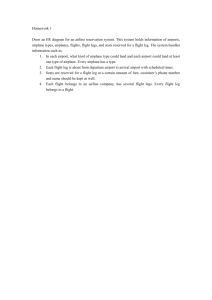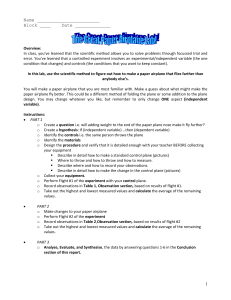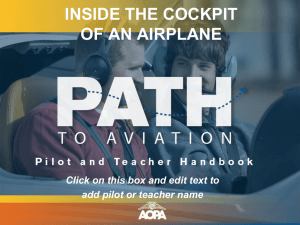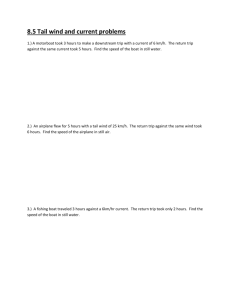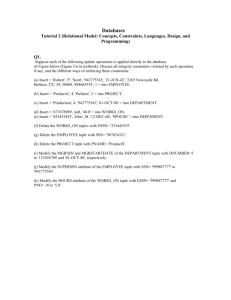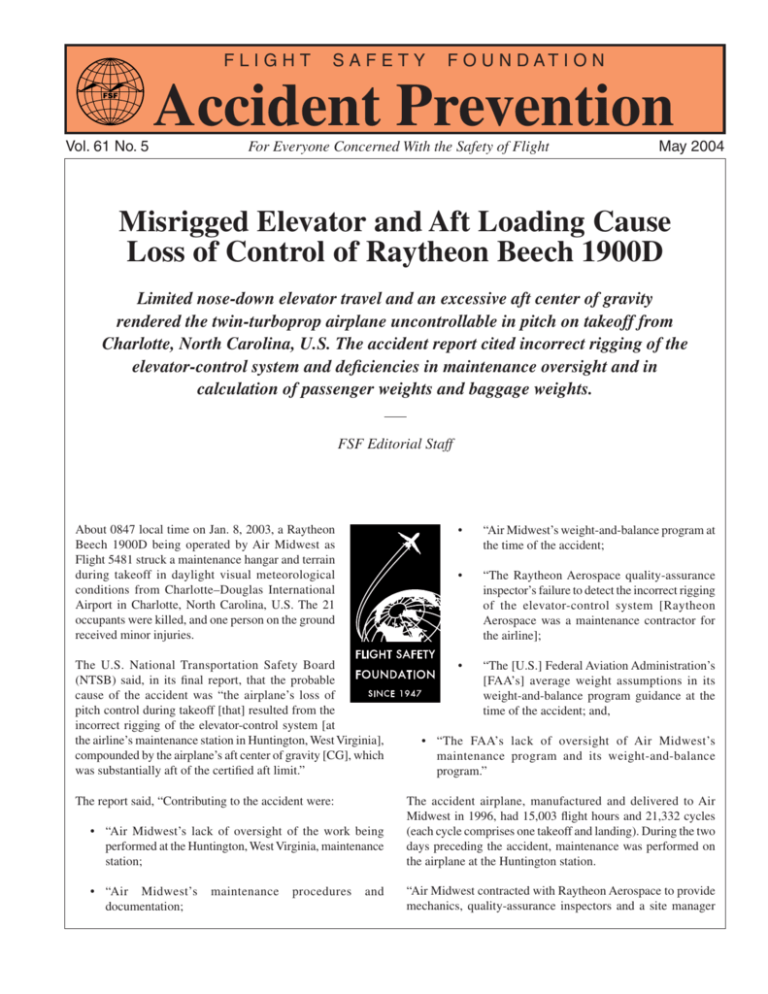
FLIGHT
SAFETY
F O U N D AT I O N
Accident Prevention
Vol. 61 No. 5
For Everyone Concerned With the Safety of Flight
May 2004
Misrigged Elevator and Aft Loading Cause
Loss of Control of Raytheon Beech 1900D
Limited nose-down elevator travel and an excessive aft center of gravity
rendered the twin-turboprop airplane uncontrollable in pitch on takeoff from
Charlotte, North Carolina, U.S. The accident report cited incorrect rigging of the
elevator-control system and deficiencies in maintenance oversight and in
calculation of passenger weights and baggage weights.
FSF Editorial Staff
About 0847 local time on Jan. 8, 2003, a Raytheon
Beech 1900D being operated by Air Midwest as
Flight 5481 struck a maintenance hangar and terrain
during takeoff in daylight visual meteorological
conditions from Charlotte–Douglas International
Airport in Charlotte, North Carolina, U.S. The 21
occupants were killed, and one person on the ground
received minor injuries.
•
“Air Midwest’s weight-and-balance program at
the time of the accident;
•
“The Raytheon Aerospace quality-assurance
inspector’s failure to detect the incorrect rigging
of the elevator-control system [Raytheon
Aerospace was a maintenance contractor for
the airline];
The U.S. National Transportation Safety Board
(NTSB) said, in its final report, that the probable
cause of the accident was “the airplane’s loss of
pitch control during takeoff [that] resulted from the
incorrect rigging of the elevator-control system [at
the airline’s maintenance station in Huntington, West Virginia],
compounded by the airplane’s aft center of gravity [CG], which
was substantially aft of the certified aft limit.”
•
“The [U.S.] Federal Aviation Administration’s
[FAA’s] average weight assumptions in its
weight-and-balance program guidance at the
time of the accident; and,
The report said, “Contributing to the accident were:
• “The FAA’s lack of oversight of Air Midwest’s
maintenance program and its weight-and-balance
program.”
• “Air Midwest’s lack of oversight of the work being
performed at the Huntington, West Virginia, maintenance
station;
The accident airplane, manufactured and delivered to Air
Midwest in 1996, had 15,003 flight hours and 21,332 cycles
(each cycle comprises one takeoff and landing). During the two
days preceding the accident, maintenance was performed on
the airplane at the Huntington station.
• “Air Midwest’s
documentation;
“Air Midwest contracted with Raytheon Aerospace to provide
mechanics, quality-assurance inspectors and a site manager
maintenance
procedures
and
for the [Huntington] maintenance station,” the report said.
“[Raytheon Aerospace] contracted with Structural Modification
and Repair Technicians, Inc. (SMART) to supply the mechanic
work force.”
Air Midwest’s regional site manager worked the day shift at the
Huntington station and was not present when the maintenance
was performed on the accident airplane. The maintenance
included visual inspections and servicing of the airplane’s major
components, and one phase of a “detail six” (D6) maintenance
check. The Air Midwest maintenance program included six D6
check phases, with a different phase conducted every 200 flight
hours. The phase conducted during the two days preceding the
accident comprised checks of the airplane’s elevator, rudder
and trim tabs.
On the night of Jan. 6, 2003, the quality-assurance inspector
at the Huntington station was providing on-the-job training
(OJT) to two SMART maintenance technicians (mechanics)
who previously had not performed a complete D6 maintenance
check. The quality-assurance inspector assigned one of
the mechanics — who had performed rigging work on de
Havilland Dash 8s — to check the tension of the elevatorcontrol cables.
“[The] quality-assurance inspector, who was providing the
mechanic’s OJT, stated that he did not think he needed to
closely supervise the mechanic because of his previous flightcontrol-rigging experience,” the report said.
The D6 inspection procedures checklist (work card) indicated
that cable tension was to be checked according to the elevatorcontrol-system rigging procedure in the Beech 1900D Airliner
Maintenance Manual. The report said that although interviews
of officials of Air Midwest and Raytheon Aircraft Co. indicated
that the entire elevator-control-system rigging procedure must
be performed when cable-tension adjustments are made, neither
the D6 work card nor the Beech 1900D maintenance manual
“explicitly stated that the entire rigging procedure needed to be
performed or that the elevator-cable-tension adjustment could
not be accomplished as an isolated task.”
Raytheon Beech 1900D
The Beech 1900D is a twin-turboprop regional transport
that entered service in 1991 and currently is manufactured
by Raytheon Aircraft Co. The airplane is a derivative of the
Beech 1900, which first flew in 1982. The 1900D has a flat
floor, a maximum cabin height of 5.9 feet (1.8 meters) and
28.5 percent more cabin volume than its predecessor, the
Beech 1900C. Standard accommodation is for two flight crew
members and 19 passengers.
The airplane is powered by two Pratt & Whitney Canada
PT6A-67D engines, each flat rated at 1,279 shaft horsepower
(954 kilowatts), and Hartzell four-blade, composite propellers.
Maximum takeoff weight is 17,120 pounds (7,766 kilograms).
Maximum landing weight is 16,765 pounds (7,605 kilograms).
Maximum cruising speed at 15,000 pounds (6,818 kilograms)
gross weight and 25,000 feet altitude is 274 knots. Stalling
speed at maximum takeoff weight with flaps retracted is 101
knots.♦
Source: Jane’s All the World’s Aircraft and Raytheon Aircraft Co.
2
The mechanic omitted several steps in the published rigging
procedure; some of the steps were omitted with the qualityassurance inspector’s concurrence.
“[The quality-assurance] inspector stated, during a postaccident
interview, that he did not think the manufacturer intended for
mechanics to follow the entire rigging procedure and that the
entire procedure had not been followed when past cable-tension
adjustments were made,” the report said.
As a result of the omitted steps, the elevator-control system
was incorrectly rigged during the D6 maintenance check, and
the incorrect rigging restricted the airplane’s elevator travel
to seven degrees nose-down — about one-half the downward
travel specified by the airplane manufacturer (i.e., 14 degrees
to 15 degrees nose-down).
“Examination of the accident airplane’s pitch-control-cable
turnbuckles as found in the wreckage revealed that the AND
[airplane-nose-down] turnbuckle, which measured 7.30 inches
FLIGHT SAFETY FOUNDATION • ACCIDENT PREVENTION • MAY 2004
[18.54 centimeters] in length, was extended 1.76 inches
[4.47 centimeters] more than the ANU [airplane nose-up]
turnbuckle, which measured 5.54 inches [14.07 centimeters]
in length,” the report said. “However, according to data from
Air Midwest’s postaccident survey of its entire fleet of 42
Beech 1900D airplanes, the AND turnbuckle was extended,
on average, only 0.04 inch [0.10 centimeter] less than the
ANU turnbuckle.
“Ground tests showed that turnbuckles adjusted to the lengths of
those found in the wreckage would result in limited downward
elevator travel. … Adjustments to the cable turnbuckles (and
possibly other adjustable components ) during maintenance
resulted in FDR [flight data recorder] measurements that
showed a nine-degree AND loss of travel, which restricted
the accident airplane’s elevator travel to seven degrees AND.”
The report said that the quality-assurance inspector did not
provide adequate OJT to the mechanic who adjusted the
elevator-control system.
“According to postaccident interviews, neither the captain nor
the first officer on those two flight legs noticed anything unusual
about the airplane,” the report said.
Flight 5481 was a regularly scheduled passenger flight
from Charlotte to Greenville–Spartanburg (South Carolina)
International Airport.
The captain, 25, had an airline transport pilot certificate
and approximately 2,790 flight hours, including 1,100 flight
hours as a Beech 1900D pilot-in-command. She was a flight
instructor and flight-school supervisor before being hired by
Air Midwest in March 2000. She earned a Beech 1900D type
rating in March 2001.
“In postaccident interviews, Air Midwest pilots who had
flown with the captain made favorable comments about her
piloting skills,” the report said. “A check airman stated that the
captain had no difficulties during upgrade training and that she
demonstrated very good knowledge of the airplane’s systems
and very good judgment. Another check airman described the
captain as one of the better company pilots and stated that she
made very good decisions about flying.
“Insufficient training and supervision resulted in the mechanic
making mistakes that led to the incorrect
rigging and the restricted downward
elevator travel,” the report said. “If the
“Insufficient training
quality-assurance inspector had provided
better training and supervision, the and supervision resulted
likelihood of such errors would have been
in the mechanic making
minimized.”
The postmaintenance checks performed
by the quality-assurance inspector and
the mechanic did not include calibration
of the pitch-position potentiometer, which
is included in the rigging procedure. The
report said that the misrigging likely would
have been found if this check had been
performed.
mistakes that led to the
incorrect rigging and
the restricted downward
elevator travel.”
“First officers stated that the captain was
a thorough and methodical pilot who
controlled the airplane well and involved them
with the flight by asking for [their] opinions
and letting them review paperwork.”
The first officer, 27, had a commercial
pilot certificate and approximately 1,096
flight hours, including 706 flight hours as a
Beech 1900D second-in-command. Before
being hired by the airline in May 2001, he
was enrolled in a college pilot-development
program for Mesa Airlines, parent company
of Air Midwest.
The rigging procedure did not include a functional check, in
which a mechanic positioned at the tail of the airplane uses a
device to measure elevator travel while another mechanic moves
the control column full forward and full aft. Raytheon Aircraft
Co. on Feb. 12, 2003, issued a revised elevator-control-systemrigging procedure that included a postmaintenance functional
check.
“In postaccident interviews, Air Midwest pilots who had flown
with the first officer made favorable comments about his piloting
skills,” the report said. “Pilots described the first officer as a
talented and very precise pilot with good attention to detail and
good communication skills. Pilots also stated that the first officer
possessed good situational awareness and good knowledge of
the Beech 1900D.”
The report said that, except for the elevator-control system, the
accident airplane was properly maintained.
The first officer did not detect the elevator’s misrigging during
his preflight inspection of the airplane.
After the airplane was released from maintenance on Jan. 7, it
was flown from Huntington to Charlotte. The first officer on that
flight told the accident first officer that “everything was normal”
and that “it was a good-flying airplane.” The accident flight
crew conducted six flights in the airplane from 1340 to 2045.
Another crew then flew the airplane to Lynchburg, Virginia,
and returned to Charlotte the next morning.
“The only visible sign of the misrig during the first officer’s
external preflight inspection would have been a change in the
elevator resting position,” the report said. “The normal elevator
resting position is between 14 degrees and 15 degrees [nosedown]; after the misrig, the elevator resting position was about
seven degrees [nose-down]. Because the horizontal stabilizer
on a parked Beech 1900D is located about 15 feet [five meters]
FLIGHT SAFETY FOUNDATION • ACCIDENT PREVENTION • MAY 2004
3
above the ground, it would be difficult to detect the change in
the elevator resting position from the ground.”
Air Midwest used an FAA-approved weight-and-balancecontrol program that allowed the use of either actual weights
or average weights of passengers and baggage. The average
weights used by Air Midwest conformed with guidance in
FAA Advisory Circular (AC) 120-27C, Aircraft Weight and
Balance Control. The circular recommended the use of average
weights derived from a survey of actual passenger weights and
baggage weights or the use of the following average weights:
180 pounds (82 kilograms) for passengers during spring and
summer months; 185 pounds (84 kilograms) for passengers
during fall and winter months; 20 pounds (nine kilograms) for
carry-on baggage; and 25 pounds (11 kilograms) for checked
baggage.
The crew used a value of 175 pounds, rather than 80 pounds,
for the 12-year-old child when they calculated the airplane’s
weight and balance.
The report said that gate agents had not attached a “heavy
bag tag” to the two heavy bags, to indicate that they weighed
between 70 pounds and 100 pounds (45 kilograms), and the
load report did not identify the bags as being overweight.
“As a result, the flight crew was not required to account for the
extra weight of the reportedly heavy bags on the load manifest
form,” the report said.
Investigators found that four of the 31 bags aboard the airplane
weighed more than 50 pounds (23 kilograms) and that the
average weight of the passengers (16 males and three females)
was 185 pounds.
The report said that the average weights used by Air Midwest
were approved but not validated by an FAA principal
Although AC 120-27C says that standard average passenger
maintenance inspector. The approved average weights used
weights cannot be used when passenger composition is
by the airline were: 170 pounds (77 kilograms) for adults in
different than 60 percent male and 40 percent female, “neither
summer; 175 pounds (79 kilograms) for adults in winter; 80
the FAA’s guidance nor Air Midwest’s weight-and-balance
pounds (36 kilograms) for children aged two through 12; 10
program identified specific nonstandard passenger weight cues
pounds (five kilograms) for carry-on items;
or thresholds to indicate when to use actual
and 25 pounds for carry-on items that did
[passenger weights] rather than average
not fit either under a passenger seat or in the
The report said that the passenger weights.”
cabin coat closet and were placed in the aft
cargo compartment.
changes resulting from The crew’s weight-and-balance calculations
also included a taxi fuel-consumption value
the misrigging of the
The flight crew used average weights for
of 220 pounds (100 kilograms), rather
the passengers and baggage when they
the airline’s standard of 110 pounds
elevator would not have than
completed a load-manifest form for the
(50 kilograms). The report said that if the
flight.
calculations had included the actual weights
been conspicuous to
of the two overweight bags and a taxi fuelthe flight crew.
Maximum takeoff weight of the Beech
consumption value of 110 pounds, the
1900D is 17,120 pounds (7,766 kilograms),
calculated gross weight would have exceeded
and the aft CG limit is 40 percent mean
the airplane’s takeoff weight limit.
aerodynamic chord (MAC). The flight crew calculated that the
airplane’s takeoff weight was 17,028 pounds (7,724 kilograms)
The airplane departed from the gate on time at 0830. About
and the CG was 37.8 percent MAC.
five minutes later, the captain (the pilot flying) conducted an
elevator-control check as part of the “Taxi” checklist. Data
The investigation determined that the actual takeoff weight was
recorded by the FDR indicated that during the check, the elevator
17,700 pounds, plus or minus 200 pounds (8,029 kilograms,
was moved from full nose-up to seven degrees nose-down.
plus or minus 91 kilograms) and that the CG was 45.5 percent
MAC, plus or minus 2 percent MAC.
The captain said, “Flight controls, free and correct.”
One of the two ramp agents who handled the baggage told
investigators that two of the checked bags were heavy; he
estimated that each bag weighed between 70 pounds and 80
pounds (32 kilograms and 36 kilograms).
“The ramp agent also stated that he told the captain that
some of the bags were heavy, although they were not marked
as such,” the report said. “According to the ramp agent, the
captain indicated that the bags were fine because a child
would be on board, which would allow for the extra baggage
weight.”
4
The report said that the changes resulting from the misrigging
of the elevator would not have been conspicuous to the flight
crew. During the investigation, three pilots with Beech 1900D
type ratings conducted control sweeps (i.e., moved the control
column full forward and full aft) in a test airplane with the
elevator rigged according to specifications and again with the
elevator misrigged similar to the accident airplane.
“The [test] pilots did not report any noticeable change in the
feel or position of the control wheel between the two sets of
control sweeps,” the report said.
FLIGHT SAFETY FOUNDATION • ACCIDENT PREVENTION • MAY 2004
At 0846, air traffic control (ATC) cleared the crew to take off
on Runway 18R and told them to turn right to a heading of 230
degrees after takeoff.
horn sounded and continued until the end of the CVR recording
about six seconds later.
FDR data indicated that the airplane pitched nose-up after liftoff although the captain applied forward pressure on her control
column and nose-down trim.
“About 0847:22, the airplane’s roll attitude stabilized at about
20 degrees left-wing-down; the pitch attitude began to increase;
and the elevator position moved in [a nose-down] direction,”
the report said. “About one second later, the elevator position
began moving in the [nose-up] direction.”
Soon after the landing gear were retracted, the cockpit voice
recorder (CVR) recorded the first officer saying “wuh,” and
the captain saying, “oh … help me.” The airplane was about
90 feet above the ground, and airspeed was 139 knots. FDR
data indicated that the airplane’s pitch attitude was 20 degrees
nose-up.
About 0847:24, the airplane rolled right through wings-level.
Two seconds later, the FDR recorded a maximum right roll of
68 degrees and a maximum vertical acceleration of 1.9 g (i.e.,
1.9 times standard gravitational acceleration).
At 0847:04, the captain said, “You got it?” FDR data indicated
that both pilots were pushing forcefully on their control
columns.
“About the same time, the captain stated, ‘Oh my god, ah,’ and
the first officer stated something similar to, ‘Uh, uh, god, ah
[expletive],’” the report said.
The CVR recording ended at 0847:28. Among the last values
“During the next eight seconds, the CVR recorded multiple
recorded by the FDR were a pitch attitude of 47 degrees nosestatements and sounds [grunts and
down, a roll attitude of 66 degrees right and
exhalations of breath] from both flight
a control-column position corresponding to
crewmembers associated with their efforts
full nose-up elevator travel.
If the airplane’s
to push the airplane’s nose down,” the report
said.
“The airplane struck a US Airways
weight and CG had
maintenance hangar on [airport] property
been within limits, the and came to rest about 1,650 feet [503
Postaccident studies in a flight simulator
indicated that an elevator position of 9.5
meters] east of the Runway 18R centerline
airplane might have
degrees nose-down would have been
and about 7,600 feet [2,318 meters] beyond
required to recover from the initial airplane
been controllable with the Runway 18R threshold,” the report
upset.
said.
At 0847:09, the CVR recorded a sound
similar to a change in the noise produced
by the engines and propellers. About one
second later, the CVR recorded the sound
of the stall-warning horn, which continued
for six seconds.
elevator travel restricted
to half the normal
nose-down travel.
At 0847:11, the captain said, “Push the nose down.”
The airplane’s nose-up pitch attitude reached a maximum of
54 degrees at 0847:13. The captain told ATC, “We have an
emergency for Air Midwest fifty-four eighty-one.”
“About 0847:18, the airplane’s pitch attitude decreased through
zero degrees and the elevator position began to move [nose-up],”
the report said. “By 0847:19, the airplane was about 1,150 feet
above ground level, and the FDR recorded a maximum left roll
of 127 degrees and a minimum airspeed of 31 knots. About one
second later, the FDR recorded a pitch attitude of 42 degrees
[nose-down].”
The captain told the first officer, “Pull the power back.”
Elevator position reached full nose-up at 0847:21. The airplane’s
pitch attitude was 39 degrees nose-down, and the stall-warning
FLIGHT SAFETY FOUNDATION • ACCIDENT PREVENTION • MAY 2004
A postaccident fire destroyed most of the
airplane structure. Autopsy reports indicated
that the cause of death for all the occupants
was “multiple blunt-force injuries due to the
airplane crash.”
“The accident was not survivable for the airplane occupants
because they were subjected to impact forces that exceeded
the limits of human tolerance,” the report said.
The report said that if the airplane’s weight and CG had been
within limits, the airplane might have been controllable with
elevator travel restricted to half the normal nose-down travel.
“The restricted elevator travel alone and the aft CG alone would
not have been sufficient to cause the uncontrolled pitch-up that
led to the Flight 5481 accident,” the report said. “[The] excessive
aft CG, which, combined with the reduced downward elevator
travel resulting from the incorrect elevator rigging, rendered
the airplane uncontrollable in the pitch axis.”
On Jan. 27, 2003, FAA issued emergency airworthiness
directive (AD) 2003-03-18, requiring operators of Beech 1900
models to inspect the elevator-control system and to verify full
elevator travel.
5
In late January 2003, FAA required air carriers that used
average-weight programs for 10-seat airplanes to 19-seat
airplanes to survey passenger weights and baggage weights. The
survey results showed that, compared to the average weights
included in AC 120-27C, average adult passengers were 21
pounds (10 kilograms) heavier, average carry-on bags were
six pounds (three kilograms) heavier and average checked bags
were four pounds (two kilograms) heavier.
“As a result, all 15 operators that were required to participate in
the survey had to adjust the weights in one or more categories
of their average-weight programs by 5 [percent] to 25 percent,”
the report said.
On May 12, 2003, FAA required all U.S. commercial aircraft
operators either to revise their average-weight programs
— by adding 10 pounds per passenger and five pounds (two
kilograms) for checked baggage — or to conduct an averageweight survey.
An aircraft weight-and-balance-control program aviation
rule-making committee, which held its first meeting in August
2003, issued draft revisions to AC 120-27C on Jan. 30, 2004.
The report said that FAA expects to solicit public comment on
proposed revisions to the AC at the end of 2004.
The report said that unlike training programs for airline pilots,
flight attendants and other personnel, the training programs
for maintenance technicians do not require formal approval
by FAA.
“FAA staff indicated that managing the content of, and ensuring
compliance with, air carrier training programs that are not
approved … can be more difficult than for programs that are
approved,” the report said.
The report said that the FAA principal maintenance inspector
assigned to Air Midwest had identified several deficiencies
in the airline’s maintenance training program during the two
years preceding the accident but that FAA had not “aggressively
pursued [improvements to] the airline’s maintenance training
program.”
“It is critical that proper FAA oversight is provided for every
air carrier maintenance training program to ensure that any
program deficiencies are identified,” the report said. “It is even
more critical for the FAA to forcefully pursue maintenance
training program improvements when deficiencies have been
identified.”
In April 2003, FAA published AC 120-79, Developing and
Implementing a Continuing Analysis Surveillance System.
The report said that the AC is a comprehensive guide for
the development of continuing maintenance analysis and
surveillance systems but that the information was not
disseminated to air carrier inspectors in FAA Order 8300.10,
Airworthiness Inspector’s Handbook.
6
Based on the findings of the investigation, NTSB made the
following recommendations to FAA:
• “Adopt a program for performing targeted surveillance
and increased oversight of maintenance practices at [U.S.
Federal Aviation Regulations Part 121] air carriers to
ensure that maintenance instructions are being followed
as written and that maintenance personnel (including, but
not limited to, management, quality assurance, tooling and
training personnel, as well as mechanics) are following
all steps in the instructions unless authorization has been
granted in accordance with the air carrier’s maintenance
program;
• “Verify that [Part 121] air carriers have procedures in their
continuing analysis and surveillance system program for
identifying deficiencies and incorporating changes to
the carrier’s maintenance program and that maintenance
personnel for these air carriers (including, but not limited
to, management, quality assurance, tooling and training
personnel, as well as mechanics) use these procedures;
• “Modify Appendix G of [Part 23], Appendix H of [Part
25] and [Part] 121.369 to require that the instructions
for continued airworthiness and air carrier maintenance
manuals, respectively, include a complete functional check
at the end of maintenance for each critical flight system;
• “Require manufacturers of aircraft operated under [Part
121] to identify appropriate procedures for a complete
functional check of each critical flight system; determine
which maintenance procedures should be followed by
such functional checks; and modify their existing
maintenance manuals, if necessary, so that they contain
procedures at the end of maintenance for a complete
functional check of each critical flight system;
• “Require [Part 121] air carriers to modify their existing
maintenance manuals, if necessary, so that they contain
procedures at the end of maintenance for a complete
functional check of each critical flight system;
• “Prohibit inspectors from performing required inspection
item inspections on any maintenance task for which
the inspector provided [OJT] to the mechanic who
accomplished the task;
• “Require [Part 121] air carriers that use contractors to
perform required inspection item (RII) maintenance
tasks and inspections to have air carrier personnel who
are physically present when a substantial amount of the
RII planning, tasking, maintenance work and inspections
are performed and are readily available when they are
not physically present and who ensure that the processes
and procedures used by contractors to perform RII
maintenance tasks and inspections are the same as those
used by air carrier maintenance personnel;
FLIGHT SAFETY FOUNDATION • ACCIDENT PREVENTION • MAY 2004
• “Develop detailed [OJT] training requirements for [Part
121] air carriers that rely on OJT as a maintenance
training method. These requirements should include, but
not be limited to, best practices, procedures and methods
for accomplishment and administration of this training.
Ensure that these OJT requirements are incorporated into
[Part 121] air carrier maintenance training programs;
• “Audit training records for personnel who are currently
performing maintenance on Air Midwest airplanes to
verify that the training was properly accomplished in
accordance with the company’s Maintenance Procedures
Manual and Maintenance Training Manual;
• “Require [Part 121] air carriers to implement a program in
which carriers and aircraft manufacturers review all work
card and maintenance manual instructions for critical
flight systems and ensure the accuracy and usability of
these instructions so that they are appropriate to the level
of training of the mechanics performing the work;
• “Include the continuing analysis and surveillance system
guidance from [AC] 120-16D, Continuing Airworthiness
Maintenance Programs, and AC 120-79 … in [the]
Airworthiness Inspector’s Handbook;
• “Require that all [Part 121] air carrier maintenance
training programs be approved;
• “Require that [Part 121] air carriers implement
comprehensive human factors programs to reduce the
likelihood of human error in aviation maintenance;
• “Identify those situations that would require the use of
actual [weights] instead of average weights in weight-andbalance computations and incorporate this information
into [AC] 120-27D;
• “Unless an actual-weight program is developed and
implemented, establish a weight-and-balance program
that requires [Part 121] air carriers to periodically sample
passenger [weights] and baggage weights, and determine
appropriate statistical distribution characteristics for regional,
seasonal, demographic, aircraft and route variances;
• “Establish a program to periodically review [Part 121] air
carrier weight-and-balance data to ensure that regional,
seasonal, demographic, aircraft and route trends among
carriers are valid;
• “Require [Part 121] air carriers to retain all survey data and
products, as well as documentation of the methodology
used to justify their average-weight programs, and audit
these data as necessary;
• “Require [Part 121] air carriers that use average-weightand-balance programs to develop and implement weight
FLIGHT SAFETY FOUNDATION • ACCIDENT PREVENTION • MAY 2004
and [CG] safety margins to account for individual
passenger [variances] and baggage variances;
• “Conduct or sponsor research to develop systems that are
capable of delivering actual aircraft weight-and-balance
data before flight dispatch. These systems should rapidly
provide accurate and reliable weight-and-balance data;
• “Promote the use of systems that deliver accurate weightand-balance data as a preferred alternative to the use of
average-weight-and-balance programs; [and,]
• “Ensure that Raytheon Aircraft Co. revises the
maintenance procedures for critical flight systems in its
Beech 1900, 1900C and 1900D Airliner Maintenance
Manuals to ensure that the procedures can be completely
and correctly accomplished.”
[NTSB issued the recommendations on March 5, 2004.
As of May 4, 2004, NTSB was awaiting response to the
recommendations from FAA.]♦
[FSF editorial note: This article, except where specifically
noted, is based on U.S. National Transportation Safety Board
Aircraft Accident Report NTSB/AAR-04/01: Loss of Pitch
Control During Takeoff; Air Midwest Flight 5481; Raytheon
(Beechcraft) 1900D, N233YV; Charlotte, North Carolina;
January 8, 2003. The 214-page report contains illustrations
and appendixes.]
Further Reading From
FSF Publications
FSF Editorial Staff. “Erroneous Roll-attitude Indication Cited
in Loss of Control of B-747 Freighter.” Accident Prevention
Volume 61 (February 2004).
FSF Editorial Staff. “Faulty Wire Installation Cited in A320
Control Problem.” Aviation Mechanics Bulletin Volume 51
(November–December 2003).
FSF Editorial Staff. “Improper Installation of Elevator Bolt
Causes DC-8 Freighter to Pitch Up Uncontrollably.” Accident
Prevention Volume 60 (October 2003).
FSF Editorial Staff. “Faulty Repair of Fuel-control Unit Cited
in Engine Flameout.” Aviation Mechanics Bulletin Volume 51
(March–April 2003).
FSF Editorial Staff. “Failure of Stabilizer-trim System Blamed
for Crew’s Loss of Control of MD-83.” Accident Prevention
Volume 60 (February 2003).
FSF Editorial Staff. “EMS Helicopter Strikes Terrain During
Maintenance Ferry Flight.” Helicopter Safety Volume 29
(January–February 2003).
7
McKenna, James T. “Maintenance Resource Management
Programs Provide Tools for Reducing Human Error.” Flight
Safety Digest Volume 21 (October 2002).
FSF Editorial Staff. “Report on A320 Decompression Faults
Maintenance Personnel’s Work on Air Packs.” Aviation
Mechanics Bulletin Volume 50 (September–October 2002).
FSF Editorial Staff. “Unsecured Fasteners in Tail-rotor System
Faulted for Bell UH-1H Loss of Control.” Helicopter Safety
Volume 28 (May–June 2002).
FSF Editorial Staff. “Improperly Installed B-747 Panels
Separate on Takeoff.” Aviation Mechanics Bulletin Volume 50
(March–April 2002).
FSF Editorial Staff. “Improper Assembly of Trim Actuator
Causes In-flight Separation of Stabilizer.” Aviation Mechanics
Bulletin Volume 49 (July–August 2001).
FSF Editorial Staff. “Fractured Bolts Blamed for Loss of
Control of Two Helicopters.” Aviation Mechanics Bulletin
Volume 49 (May–June 2001).
FSF Editorial Staff. “Incorrect Installation of Battery Cable
Blamed for Fire That Destroyed Helicopter.” Aviation
Mechanics Bulletin Volume 49 (March–April 2001).
FSF Editorial Staff. “Documentation, Inspection, Workload
Problems Cited in Incorrect Installation of Aileron-trim Cables.”
Aviation Mechanics Bulletin Volume 49 (January–February
2001).
Crotty, Bart J. “Improperly Installed Trim Actuators Blamed
for Takeoff Accident.” Aviation Mechanics Bulletin Volume 48
(September–October 2000).
FSF Editorial Staff. “Improper Loading of Cargo Causes Loss
of Aircraft Control on Approach.” Accident Prevention Volume
57 (May 2000).
Crotty, Bart J. “Omission of Oil-plug Seals Leads to In-flight
Engine Shutdowns.” Aviation Mechanics Bulletin Volume 47
(July–August 1999).
FSF Editorial Staff. “Undetected Wear of Turbine-shroud Seals
Leads to Engine Failure, Emergency Landing.” Helicopter
Safety Volume 25 (May–June 1999).
FSF Editorial Staff. “Loose Connection on Battery Shunt
Involved in Boeing 767 Emergency-landing Incident.” Aviation
Mechanics Bulletin Volume 47 (January–February 1999).
FSF Editorial Staff. “Misloaded Douglas DC-8 Pitches Up
Excessively on Takeoff, Then Stalls and Strikes the Ground.”
Accident Prevention Volume 55 (September 1998).
Crotty, Bart J. “Unrecorded Maintenance on Fokker 100 Liftdumper System Leads to Wing-surface Damage in Flight.”
Aviation Mechanics Bulletin Volume 46 (May–June 1998).
Want more information about Flight Safety Foundation?
Contact Ann Hill, director, membership and development,
by e-mail: hill@flightsafety.org or by telephone: +1 (703) 739-6700, ext. 105.
Visit our Internet site at <www.flightsafety.org>.
We Encourage Reprints
Articles in this publication, in the interest of aviation safety, may be reprinted, in whole or in part, but may not be offered for sale, used commercially or
distributed electronically on the Internet or on any other electronic media without the express written permission of Flight Safety Foundation’s director
of publications. All uses must credit Flight Safety Foundation, Accident Prevention, the specific article(s) and the author(s). Please send two copies of
the reprinted material to the director of publications. These restrictions apply to all Flight Safety Foundation publications. Reprints must be ordered from
the Foundation.
What’s Your Input?
In keeping with the Foundation’s independent and nonpartisan mission to disseminate objective safety information, FSF publications solicit credible
contributions that foster thought-provoking discussion of aviation safety issues. If you have an article proposal, a completed manuscript or a technical paper
that may be appropriate for Accident Prevention, please contact the director of publications. Reasonable care will be taken in handling a manuscript, but
Flight Safety Foundation assumes no responsibility for material submitted. The publications staff reserves the right to edit all published submissions. The
Foundation buys all rights to manuscripts and payment is made to authors upon publication. Contact the Publications Department for more information.
Accident Prevention
Copyright © 2004 by Flight Safety Foundation Inc. All rights reserved. ISSN 1057-5561
Suggestions and opinions expressed in FSF publications belong to the author(s) and are not necessarily endorsed by
Flight Safety Foundation. This information is not intended to supersede operators’/manufacturers’ policies,
practices or requirements, or to supersede government regulations.
Staff: Roger Rozelle, director of publications; Mark Lacagnina, senior editor; Wayne Rosenkrans, senior editor; Linda Werfelman, senior editor;
Rick Darby, associate editor; Karen K. Ehrlich, web and print production coordinator; Ann L. Mullikin, production designer;
Susan D. Reed, production specialist; and Patricia Setze, librarian, Jerry Lederer Aviation Safety Library
Subscriptions: One year subscription for twelve issues includes postage and handling: US$240. Include old and new addresses when requesting
address change. • Attention: Ahlam Wahdan, membership services coordinator, Flight Safety Foundation, Suite 300, 601 Madison Street,
Alexandria, VA 22314 U.S. • Telephone: +1 (703) 739-6700 • Fax: +1 (703) 739-6708.
8
FLIGHT SAFETY FOUNDATION • ACCIDENT PREVENTION • MAY 2004

